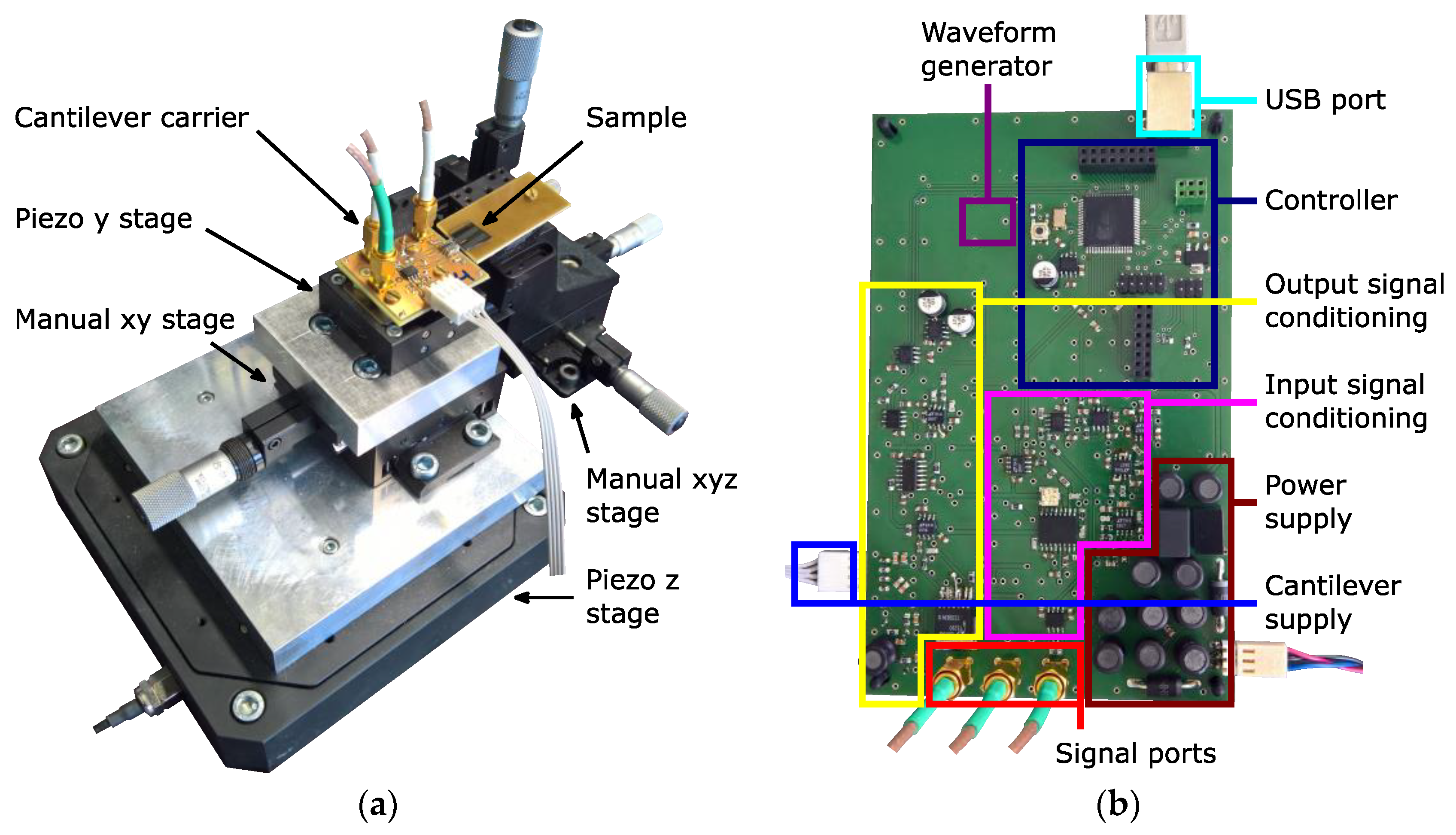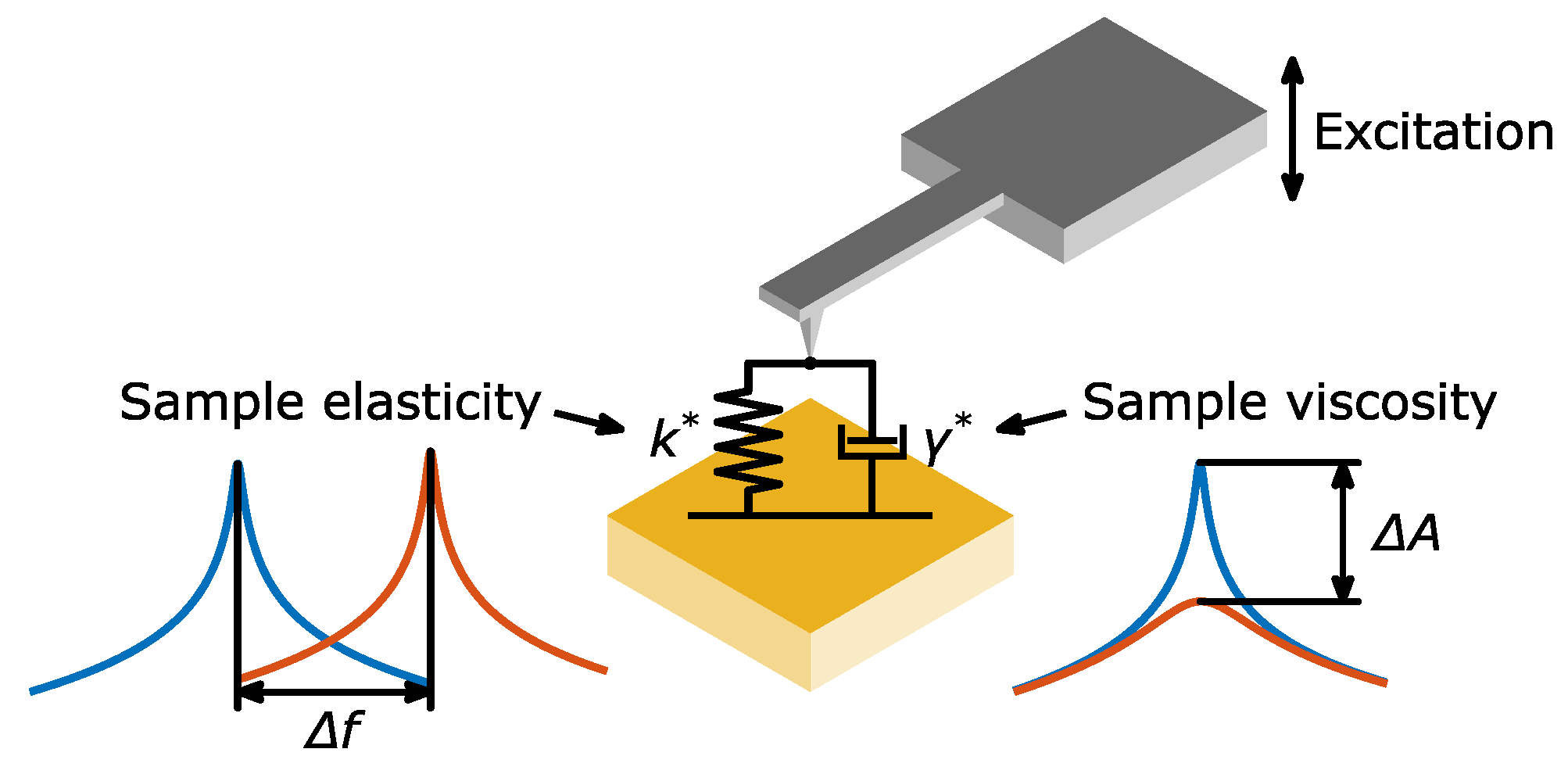Optimizing a Cantilever Measurement System towards High Speed, Nonreactive Contact-Resonance-Profilometry †
Abstract
:1. Introduction
2. Measurement Setup and Theory
3. Results
4. Conclusions
Author Contributions
Acknowledgments
Conflicts of Interest
References
- Hofmann, E.; Rüsch, M. Industry 4.0 and the current status as well as future prospects on logistics. Comput. Ind. 2017, 89, 23–34. [Google Scholar] [CrossRef]
- Tapia, G.; Elwany, A. A Review on Process Monitoring and Control in Metal-Based Additive Manufacturing. J. Manuf. Sci. Eng. 2014, 136, 60801. [Google Scholar] [CrossRef]
- Wasisto, H.S.; Doering, L.; Brand, U.; Peiner, E. Ultra-high-speed cantilever tactile probe for high-aspect-ratio micro metrology. In Proceedings of the 2015 Transducers—2015 18th International Conference on Solid-State Sensors, Actuators and Microsystems (TRANSDUCERS), Anchorage, AK, USA, 21–25 June 2015; IEEE: Piscataway, NJ, USA, 2015; pp. 1061–1064. [Google Scholar] [CrossRef]
- Technische Beschreibung: Piezoresistiver Mikrotaster, CiS Forschungsinstitut für Mikrosensorik GmbH, Datasheet. Available online: https://www.cismst.org/fileadmin/user_upload/publikationen/cantilever.pdf (accessed on 16 April 2018).
- Kocun, M.; Ohler, B. Exploring Nanoscale Viscoelastic Properties. Imaging Microsc. 2013, 15, 22–24. [Google Scholar]
- Bertke, M.; Fahrbach, M.; Hamdana, G.; Xu, J.; Wasisto, H.S.; Peiner, E. Contact resonance spectroscopy for on-the-machine manufactory monitoring. Sens. Actuators A Phys. 2018, 279, 501–508. [Google Scholar] [CrossRef]
- Bertke, M.; Reinheimer, U.W.; Fahrbach, M.; Hamdana, G.; Wasisto, H.S.; Peiner, E. Piezo Resistive Read-Out Contact Resonance Spectroscopy for Material and Layer Analysis at High-Aspect-Ratio Geometries. Proceedings 2017, 1, 371. [Google Scholar] [CrossRef]




| APLL | SPLL v1 | SPLL v2 | SPLL v3 | |
|---|---|---|---|---|
| Frequency range (kHz) | 13 to 16.5 | 1 to 100 | 1 to 400 | 1 to 500 |
| Phase detection range (°) | −180 to 0 | −180 to 180 | −180 to 180 | −180 to 180 |
| Phase lock condition (°) | −90 | −180 to 180 | −180 to 180 | −180 to 180 |
| Excitation amplitude (V) | 2.5 | 2.5 | 0 to 2.5 | 0 to 3 |
| Typical control speed (Hz / ° / s) | 79 | 2 | 2 | 5 |
| Sample rate (S/s) | 1 | 50 | 100 | 300 |
| AGC capable | no | no | no | yes |
Publisher’s Note: MDPI stays neutral with regard to jurisdictional claims in published maps and institutional affiliations. |
© 2018 by the authors. Licensee MDPI, Basel, Switzerland. This article is an open access article distributed under the terms and conditions of the Creative Commons Attribution (CC BY) license (https://creativecommons.org/licenses/by/4.0/).
Share and Cite
Fahrbach, M.; Krieg, L.; Voss, T.; Bertke, M.; Xu, J.; Peiner, E. Optimizing a Cantilever Measurement System towards High Speed, Nonreactive Contact-Resonance-Profilometry. Proceedings 2018, 2, 889. https://doi.org/10.3390/proceedings2130889
Fahrbach M, Krieg L, Voss T, Bertke M, Xu J, Peiner E. Optimizing a Cantilever Measurement System towards High Speed, Nonreactive Contact-Resonance-Profilometry. Proceedings. 2018; 2(13):889. https://doi.org/10.3390/proceedings2130889
Chicago/Turabian StyleFahrbach, Michael, Linus Krieg, Tobias Voss, Maik Bertke, Jiushuai Xu, and Erwin Peiner. 2018. "Optimizing a Cantilever Measurement System towards High Speed, Nonreactive Contact-Resonance-Profilometry" Proceedings 2, no. 13: 889. https://doi.org/10.3390/proceedings2130889
APA StyleFahrbach, M., Krieg, L., Voss, T., Bertke, M., Xu, J., & Peiner, E. (2018). Optimizing a Cantilever Measurement System towards High Speed, Nonreactive Contact-Resonance-Profilometry. Proceedings, 2(13), 889. https://doi.org/10.3390/proceedings2130889





